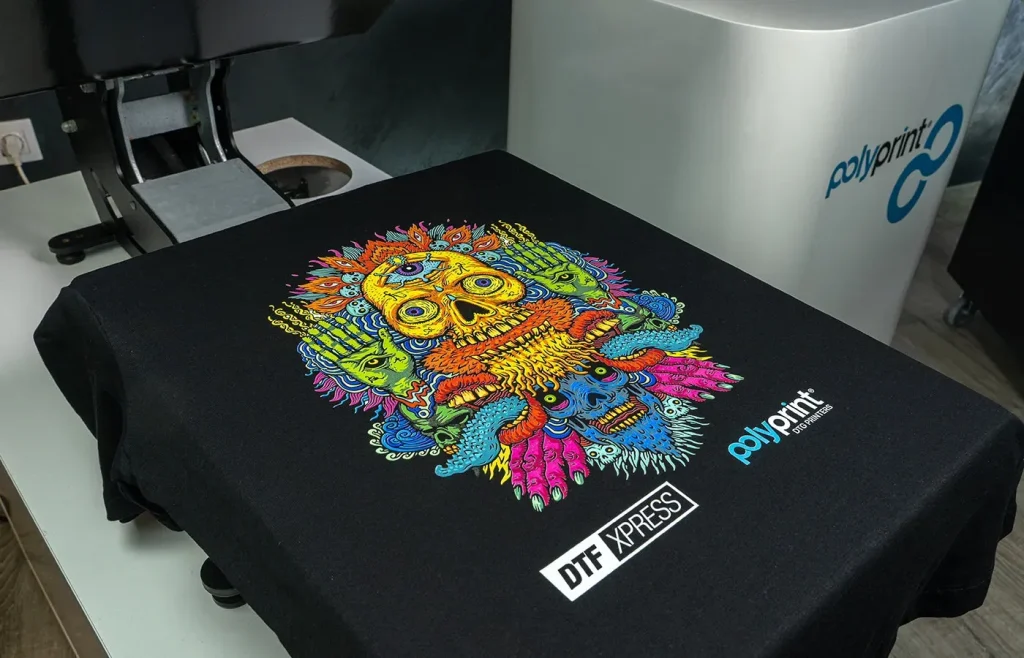DTF printing, or Direct-to-Film printing, has revolutionized the textile printing landscape by offering a vibrant and durable solution for transferring designs onto various fabrics. This innovative printing technique is quickly becoming favored among artists and businesses alike, primarily due to its ability to produce high-quality images with ease. The DTF print process utilizes specialized inks and transfer films, allowing intricate designs to be heat-pressed onto materials such as cotton and polyester without the need for pre-treatment. With several DTF printing advantages, including versatility and cost-effectiveness, it’s no wonder many are eager to learn how to start DTF printing. In this guide, we will delve into everything you need to know about DTF printing, exploring its functionalities, benefits, and the steps required to initiate your own printing journey.
Known as Direct-to-Film printing, this method is making waves in the world of custom fabric design. By using a unique transfer film, artists can apply vivid colors and intricate patterns onto a wide array of textiles. Unlike traditional techniques, the DTF print process allows for high-resolution images without complicated pre-treatment requirements, making it accessible for newcomers. The benefits of this technique extend to its adaptability across different fabric types, and its affordability makes it an attractive option for startups and hobbyists alike. So, if you’re curious about what is DTF printing and how it can elevate your creative projects, you’re in the right place!
Understanding the DTF Print Process
The Direct-to-Film (DTF) print process involves several key steps that contribute to its efficiency and quality. Initially, designs are printed onto a special transfer film using a DTF printer that utilizes advanced ink technology. After printing, a heat-activated adhesive powder is sprinkled onto the wet ink, which is then cured to bond the ink and adhesive. The final step requires transferring the design from the film onto the fabric using a heat press, ensuring a strong adhesion that results in vivid prints.
This method distinguishes itself from traditional printing techniques like Direct-to-Garment (DTG) printing by being adaptable to various fabric types. Unlike DTG, which primarily works best on cotton, DTF printing allows for applications on polyester and mixed fabrics. This versatility opens up a wider range of possibilities for designers and businesses, enabling them to cater to different customer tastes and preferences. Therefore, mastering the DTF print process is essential for anyone looking to venture into the world of textile printing.
Key Advantages of DTF Printing
One of the most significant advantages of DTF printing is its incredible versatility. It enables high-quality outputs on a variety of materials, from cotton to blends, making it an attractive choice for custom apparel businesses. This technique can produce intricate and colorful designs that stand out on various fabric colors, both light and dark. As a result, it provides flexibility for creative projects, whether you’re designing for fashion, events, or custom merchandise.
Cost-effectiveness is another crucial advantage of DTF printing, especially for small batch orders. Unlike traditional screen printing, which often requires minimum quantities to be financially justifiable, DTF printing allows for economical printing of smaller runs. This accessibility makes it particularly appealing for hobbyists and small business owners who may be venturing into custom print work without heavy initial investments. Ultimately, the advantages of DTF printing position it as a valuable option in the textile printing industry.
Essential Equipment for DTF Printing
Starting with DTF printing necessitates the right equipment to achieve the best results. Key components include a high-quality DTF printer, a reliable heat press, and specialized transfer films designed for the DTF print process. The printer must be capable of handling the unique inks used in DTF printing, which play a critical role in achieving high vibrancy and durability in prints. Additionally, a heat press with adjustable temperature and pressure settings is vital to ensure proper adhesion of the design to the fabric.
It is advisable to research various brands and models before making a purchase. Look for reviews and recommendations from current users to identify equipment that aligns with your specific printing needs and budget. Investing in quality equipment not only enhances the print quality but also streamlines the printing process, making it easier for beginners to achieve professional results.
Tips on How to Start DTF Printing
Once you’ve selected your DTF printing equipment, the next step involves mastering the process of creating designs suitable for printing. Critical to this phase is using design software that supports the DTF printing format. Software like Adobe Illustrator and CorelDRAW offers the tools needed to design intricate graphics, ensuring that your prints translate well from the digital canvas to the fabric. It’s important to pay attention to file formats and color settings to avoid discrepancies during printing.
Furthermore, conducting test prints is a necessary practice to perfect your DTF printing skills. Start by using sample fabrics to test various inks, temperature settings, and transfer times. This experimentation phase will help you refine your technique and troubleshoot any issues when translating designs from your computer to the fabric. By developing a systematic approach to testing, you can produce high-quality prints that meet the expectations of your intended audience.
Challenges Faced in DTF Printing
While DTF printing offers numerous advantages, it is not without its challenges. One significant hurdle is the initial equipment costs; investing in quality printers and heat presses can be daunting for newcomers. This upfront financial commitment necessitates careful consideration of projected print volumes and budget constraints. Those looking to enter the DTF printing arena should weigh these initial outlays against the potential return on investment from offering quality custom prints.
Additionally, DTF printing does require a learning curve. Beginners must develop a solid understanding of the DTF print process and troubleshooting common issues, such as ink settings and heat application. Practicing on various fabrics will aid in honing these skills, but patience is critical as you navigate the early stages. Embracing a mindset of continuous learning will provide the confidence necessary to overcome these challenges and succeed in DTF printing.
Future Trends in DTF Printing Technology
Recent developments in DTF printing technology signal a promising future for this printing method. Many businesses have begun adopting DTF printing due to its ability to produce on-demand custom apparel quickly and efficiently. As technology evolves, there is an ongoing trend towards developing higher-quality inks that enhance color vibrancy and durability, catering to consumer demands for high-performance prints.
Moreover, advancements in printing equipment, such as improved DTF printers and heat presses, are making the process smoother and more efficient. As the market continues to grow, innovations are likely to emerge, bringing additional capabilities and improvements to the DTF print process. Staying informed about these trends and technologies will allow businesses and individuals to remain competitive in the custom printing landscape, ensuring an exciting journey ahead in DTF printing.
Frequently Asked Questions
What is DTF printing and how does it work?
DTF printing, or Direct-to-Film printing, is a process that applies designs onto a specialized transfer film using a DTF printer. This film is then heat pressed onto various fabrics, allowing for high-quality, vibrant prints. Unlike DTG printing, DTF can be used on multiple fabric types, making it a versatile option for custom apparel.
What are the advantages of using DTF printing?
DTF printing offers several advantages, including versatility on different fabrics, ease of use without pre-treatment, cost-effectiveness for small batches, and exceptional durability of prints. These features make DTF printing an appealing choice for both beginners and professionals in the apparel industry.
How can I start DTF printing as a beginner?
To start DTF printing, first select the right equipment, which includes a quality DTF printer and heat press. Then, choose specialized DTF inks and graphic design software compatible with the printing process. Begin with test runs on sample fabrics to perfect your technique and ensure high-quality outputs.
What makes DTF printing a cost-effective option for small businesses?
DTF printing is cost-effective for small businesses because it allows for small batch orders without the high costs associated with traditional screen printing. This flexibility enables businesses to produce custom apparel economically, ensuring they can meet customer demands without significant investment.
What challenges should I expect when starting DTF printing?
While DTF printing is user-friendly, beginners may face challenges such as the initial equipment costs and a learning curve in achieving desired print quality. Investing time to practice and troubleshoot print settings will help overcome these challenges for better results.
What advancements are being made in DTF printing technology?
Recent advancements in DTF printing technology include improved ink formulations that enhance color vibrancy and durability. As more small businesses adopt DTF printing, manufacturers continue to innovate equipment and materials, making this method increasingly efficient and versatile for custom apparel.
| Key Points | Details |
|---|---|
| What is DTF Printing? | DTF printing is a method where designs are printed onto transfer film which is then heat pressed onto fabrics. It can work on various materials, making it more versatile than DTG printing. |
| Advantages of DTF Printing | 1. Versatility: Works on multiple fabric types. 2. Ease of Use: No need for pre-treatment. 3. Cost-Effectiveness: Great for small batch orders. 4. Durability: Prints resist cracking and peeling. |
| Challenges in DTF Printing | 1. Initial Equipment Costs: Quality equipment can be expensive. 2. Learning Curve: Requires practice to master the technique. |
| Getting Started with DTF Printing | 1. Select the Right Equipment: Ensure your printer and heat press are suitable for DTF. 2. Quality Inks: Use specialized inks for vibrant prints. 3. Design Software: Use software compatible with DTF printing. 4. Testing Prints: Conduct sample tests to fine-tune settings. |
| Recent Developments | Increased adoption by small businesses and continuous innovations in ink formulations for better vibrancy and durability. |
Summary
DTF printing is a revolutionary printing method that brings endless possibilities in custom apparel design. From its ability to handle a variety of fabrics to its cost-effectiveness for small print runs, DTF printing offers an ideal solution for both hobbyists and businesses alike. This guide provides you with crucial insights on DTF printing, covering everything from essential equipment to the latest advancements in the industry, empowering you to embrace this cutting-edge technology. As you explore your creativity through DTF printing, you’ll appreciate the vibrancy and durability your designs can achieve.



